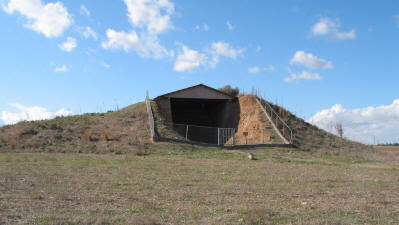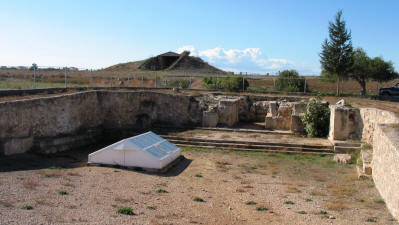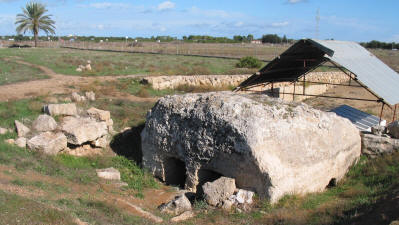The Royal Tombs
Salamis, Near Famagusta, North Cyprus
The royal tombs (sometimes called the kings tombs) are located in an area between Tuzla and Salamis. The entrance to the complex is close to St Barnabas' Monastery.
 |
| Tomb 3 |
This site became famous in the 1950s because of the rich finds here. Until the end of the 19th century, however there was almost a "free for all" for treasure hunters. At the start of the 20th century, however, more scientific excavation was started. Unfortunately, the methods used in those days also caused some damage. However, in every case, the entrance way (dromos) had been undisturbed, and it was in this area that the richest discoveries were made.
The tombs date to the 8th and 7th centuries BC. Some go back to the 11th century BC, suggesting that for some time, Salamis coexisted with Enkomi.
The funerary rites of the tombs are very similar. In all, at least one pair of yoked horses has been sacrificed in the dromos, with or without a chariot. The wooden parts of these chariots had decayed, but left impressions in the soil with the metal parts still in place. In tomb 3, excavated in 1964, one chariot was accompanied by the deceased's armour, a silver studied sword, some bronze and iron-headed arrows, a bronze shield and an iron-headed spear. Offerings of food and honey, placed in amphora, were also found here.
Tomb 1, excavated in 1957, contained two burials from different periods. The first consisted of a bronze cauldron containing the cremated bones of a dead woman wrapped in cloth, with a necklace of gold, rock crystal beads and several thin sheets of gold. It is thought because of the shape of the tomb and the richness of the material, the burial belonged to a noble lady or princess. The skeletons of two horses were found on the floor of the dromos, with traces of the wooden parts of a chariot. These date to middle of the 8th century BC. The second burial, around 100 years later was disturbed badly, but four horses' skeletons, traces of a two-poled chariot, as well as some metal parts of horses' gear and a chariot's metal parts were found.
 |
| Tomb 47 (Tomb 3 in the Background) |
Tombs 79 and 47 provided the richest finds, with evidence of several elaborate royal burials. Tomb 47 is the largest, and is alongside the Royal Tombs Museum. It was excavated in 1964. It has a spacious cemented dromos leading to a monumental temple in front of a chamber built of enormous well-dressed stones.
This tomb was used twice for burials. In the first, two horses of a hearse were sacrificed. One of the horses had tried to escape when its companion was killed, but had twisted round the chariot pole and was found with its neck broken. The iron bits of the horses were still in their mouths, and the remains of leather frontlets and blinkers covered with sheets of gold on their heads. There was no trace of the chariot in this burial, and it was probably used as a hearse and placed with the body.
At a later burial, six horses were sacrificed, yoked in pairs, with ornamental coverings, iron bits and blinkers and frontlets of ivory and bronze with relief decorations of lotus flowers.
The best finds, however, are from tomb 79, just south of tomb 47. Evidence shows that it received two burials in a short space of time towards the end of the 8th century BC. A four-horse chariot had its wheels held by magnificent lynch pins nearly 2 ft long, with a bronze sphinx head at one end, and a hollow bronze figure of a warrior at the other, wearing a crested helmet, body armour inlaid with blue glass, and a long sword hanging from a baldric.
 |
| Tomb 79 |
A two-horse hearse had bronze lion heads on the corners and on the front The bronze gear of the horses lay piled in a corner, including breast plates with embossed designs of oriental animals and myths, and two side pendants showing the goddess Ishtar as mistress of the wild beasts. |Also of oriental design was a bronze tripod cauldron decorated with illustrations of griffins and bird-men round the rim.
The principal find at this tomb was a number of ivories, including a gold and ivory throne and an ivory-veneered bed. Of the ornaments discovered, the finest was probably an openwork, two-sided plaque of a winged sphinx wearing the crowns of Egypt.
Some of the horse skeletons have been left in situ, and there is a small museum on site showing some of the finds, although most are now elsewhere, the bed for example being in the Cyprus Museum in south Nicosia.
There is no evidence to show that these Royal Tombs belonged to the kings of Salamis, but with the precious death gifts, and the monumental architecture of the tombs, there is no doubt that they belonged to noble or rich persons.
And the less noble or rich? They were buried at the Necropolis of Cellarka, which is to be found within this complex, as is Tomb 50, commonly known as St Catherine's prison.
See the location in Google maps.
Return to Salamis Index or Famagusta Index.